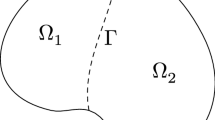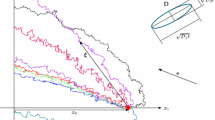Abstract
In the magnetic diffusion problem, a magnetic diffusion equation is coupled by an Ohmic heating energy equation. The Ohmic heating can make the magnetic diffusion coefficient (i.e. the resistivity) vary violently, and make the diffusion a highly nonlinear process. For this reason, the problem is normally very hard to be solved analytically. In this article, under the condition of a step-function resistivity and a constant boundary magnetic field, we successfully derived an exact solution for this nonlinear problem. The solution takes four parameters as input: the fixed magnetic boundary \(B_0\), \(\eta _{\text {S}}\) and \(\eta _{\text {L}}\) that are resistivities below and above the critical energy density of a material, and the critical energy density \(e_{\text {c}}\) of the material. The solution curve B(x, t) possesses the characteristic of a sharp front, and its evolution obeys the usual self-similar rule with the similarity variable \(x/\sqrt{t}\).





Similar content being viewed by others
Data Availability Statement
The manuscript has associated data in a data repository. [Authors’ comment: The data that support the findings of this study are available from the corresponding author upon reasonable request].
Notes
This conclusion is in fact just a different way of expression to the well-known property for the self-similar solution of a usual diffusion equation, where it is usually stated like “the self-similarity variable is \(x/\sqrt{t}\)”.
It can be seen from Eq. (25) that the integration in Eq. (16) is finally independent of x. This fact is a key for the existence of a self-similarity solution for the magnetic diffusion coupled by Ohmic heating. (This footnote can be taken as a response to the discussions about self-similarity on the head of Sec. 3).
References
T.J. Burgess, Electrical resistivity model of metals, in Presented at the 4th International Conference on Megagauss Magnetic-Field Generation and Related Topics, Santa Fe, N. Mex., 14 Jul. 1986, (1986)
D. Zou, X. Chunguang, H. Dong, J. Liu, A shock-fitting technique for cell-centered finite volume methods on unstructured dynamic meshes. J. Comput. Phys. 345, 866–882 (2017)
H.S. Carslaw, J.C. Jaeger, Conduction of Heat in Solids (Oxford University Press, London, 1959)
C. Zhu, Y. Deng, Tutorial on Partial Differential Equations (China Machine Press, Beijing, 2005)
M. Caputo, M. Fabrizio, A new definition of fractional derivative without singular Kernal. Prog. Fract. Differ. Appl. 1(2), 73–85 (2015)
K. Oldham, J. Spanier, The Fractional Calculus (Academic Press, New York, 1974)
O.P. Agrawal, Application of fractional derivatives in thermal analysis of disk brakes. Nonlinear Dyn. 38, 191–206 (2004)
B.B. Iskender Eroglu, D. Avci, Separable solutions of Cattaneo–Hristov heat diffusion equation in a line segment: Cauchy and source problems. Alex. Eng. J. 60(2), 2347–2353 (2021)
J. Hristov, An alternative integral-balance solutions to transient diffusion of heat (mass) by time-fractional semi-derivatives and semi-integrals: fixed boundary conditions. Therm. Sci. 20(6), 1867–1878 (2016)
J. Hristov, Transient heat diffusion with a non-singular fading memory: from the Cattaneo constitutive equation with Jeffrey’s kernel to the caputo-fabrizio time-fractional derivative. Therm. Sci. 20(2), 757–762 (2016)
J. Hristov, Double integral-balance method to the fractional subdiffusion equation: approximate solutions, optimization problems to be resolved and numerical simulations. J. Vib. Control 23(7), 2795–2818 (2017)
J. Hristov, Magnetic field diffusion in ferromagnetic materials: fractional Calculs approaches. Int. J. Optim. Control Theories Appl. 11(3), 1–15 (2021)
V.V. Kulish, J.L. Lage, Fractional-diffusion solutions for transient local temperature and heat flux. J. Heat Transf. 122(2), 372–376 (2000)
N. Sene, Analytical solutions of Hristov diffusion equations with non-singular fractional derivatives. Chaos 29, 023112 (2019)
O. Schnitzer, Fast penetration of Megagauss fields into metallic conductors. Phys. Plasmas 21(8), 082306 (2014)
B. Xiao, G. Zhuowei, M. Kan, G. Wang, J. Zhao, Sharp-front wave of strong magnetic field diffusion in solid metal. Phys. Plasmas 23(8), 082104 (2016)
C. Yan, B. Xiao, G. Wang, P. Li, Higher order corrections to the sharp-front magnetic diffusion wave formulas. AIP Adv. 11(5), 055201 (2021)
P.A. Davidson, Cambridge Texts in Applied Mathematics: An Introduction to Magnetohydrodynamics (Cambridge University Press, Cambridge, 2001)
C. Yan, B. Xiao, Y. Lu, G. Wang, P. Li, A finite volume scheme based on magnetic flux and electromagnetic energy flow for solving magnetic field diffusion problems. Chin. J. Comput. Phys. 39(4), 7 (2022)
Acknowledgements
Shu was partially supported by the National Natural Science Foundation of China (No. 12371373). Feng and Zhao were partially supported by the National Key Research and Development Program of China (Grant No. 2023YFB3001604), the National Natural Science Foundation of China (No. 12371373) and the GHfund A (202302011094).
Author information
Authors and Affiliations
Corresponding author
Ethics declarations
Conflict of interest
The authors declare that they have no known competing financial interests or personal relationships that could have appeared to influence the work reported in this paper.
Rights and permissions
Springer Nature or its licensor (e.g. a society or other partner) holds exclusive rights to this article under a publishing agreement with the author(s) or other rightsholder(s); author self-archiving of the accepted manuscript version of this article is solely governed by the terms of such publishing agreement and applicable law.
About this article
Cite this article
Xiao, B., Wang, G., Zhao, L. et al. An exact solution for the magnetic diffusion problem with a step-function resistivity model. Eur. Phys. J. Plus 139, 305 (2024). https://doi.org/10.1140/epjp/s13360-024-05086-2
Received:
Accepted:
Published:
DOI: https://doi.org/10.1140/epjp/s13360-024-05086-2




